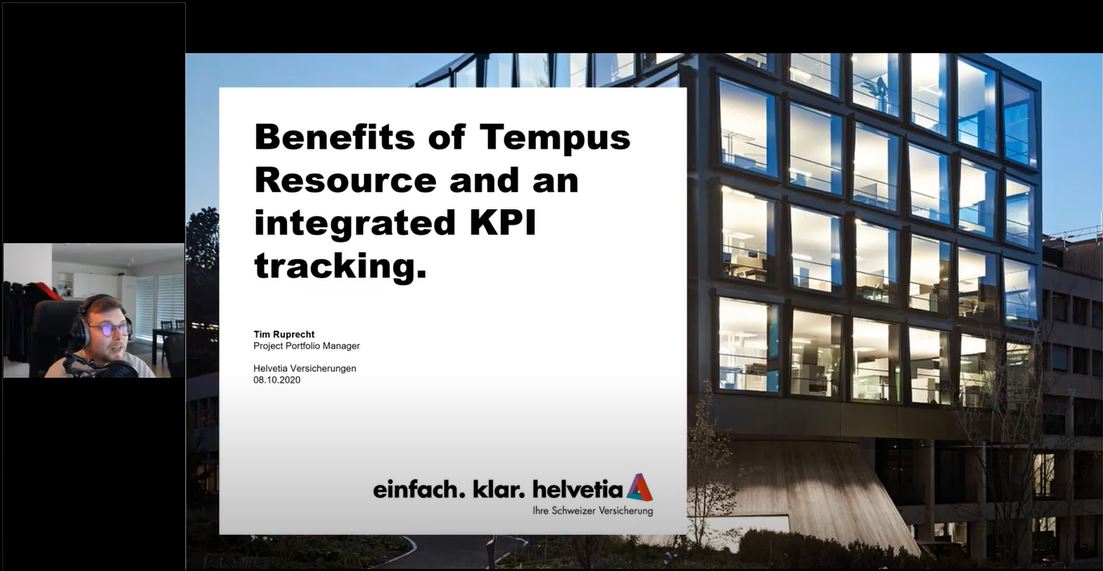Resource Management, Conference, Webinar

You can watch the replay of Tim Ruprecht’s full presentation, “Integrated Resource Management – Benefits of Tempus Resource and integrated KPI tracking,” below:
Tim Ruprecht of Helvetia Insurance presented at the Tempus Resource 2020 European Virtual Conference on October 8, 2020.
With a portfolio of 256 projects of various sizes and in all stages of completion, “resource conflicts were guaranteed, especially in the IT department” of Helvetia Insurance. Tim Ruprecht, Project Portfolio Manager at Helvetia, described one of the organization’s main problems as lack of transparency into project status, dependencies, and resource bottlenecks. In his presentation at the Tempus Resource 2020 European Virtual Conference, Ruprecht outlined Helvetia’s use of Tempus to address their transparency challenges and ensure PMs and RMs have the tools, reporting, and escalation channels needed to run projects smoothly to completion.
Helvetia selected Tempus for its capacity to track every project in their portfolio, identify conflicts early, gain visibility into project dependencies, and identify bottlenecked resources. Ruprecht found that Tempus’s dashboard and visualization capabilities were key to gaining acceptance and organization-wide use. As was Helvetia’s ability to integrate Tempus seamlessly into their software landscape.
“Within the first five months of using Tempus, we saw where there was high utilization, which is a strong indicator for bottlenecks. We started asking why. Do we need knowledge transfer? Do we need another FT? And then we could communicate those needs to management and clear the bottlenecks.”
-Tim Ruprecht, Helvetia
In terms of process changes, Helvetia began by articulating the job responsibilities for four roles, including Resource Manager, Project Manager, and Project Portfolio Manager. With clearer role definition, resource managers no longer oversee prioritization, but can focus on protecting their resources and managing allocations. One new role, the Conflict Committee, has been integral to making improvements. The Conflict Committee is a project portfolio board dedicated to addressing resource conflicts, which now have an official channel for escalation and resolution. Monthly planning cycles have also helped Helvetia manage conflicts and decisions with transparency.
The benefits of PPM with Tempus are tracked via four main KPIs: Resource Request Approvals—at the resource and project levels; Plan vs. Actual Work; and Unplanned Actual Hours Ratio. All data is collected via Tempus and managed with the Tempus Sheets function, meaning they can track time data and project costs all with a single tool. Additionally, all KPI reporting is done monthly and provided to stakeholders with a monthly lookback. By focusing their reporting on stakeholder needs and even co-developing reports with stakeholders, Helvetia enables its managers to “make more sure and reliable decisions.”
Helvetia’s new PPM capabilities include easily adjusting project plans, a clear look at budget plans vs. actuals, and a set process to resolve resource conflicts. “The main benefit of Tempus has been transparency. We know every project that is running, how much money and resources they need, and what conflicts exist,” Ruprecht explains. Furthermore, he cites major improvements in project tracking, financial forecasting, budget tracking, and portfolio-level feasibility assessment. The next steps in Helvetia’s PPM roadmap include further reporting enhancements and continued project and portfolio success.
To learn more about how Resource Portfolio Management can help your organization enhance decision making through better visibility and control, contact ProSymmetry, makers of Tempus Resource. And be sure to check out all of our speakers from the Tempus Resource 2020 European Virtual Conference.